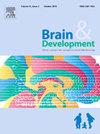脑脊液谷氨酸盐作为儿童急性脑病的诊断标志物。
IF 1.3
4区 医学
Q4 CLINICAL NEUROLOGY
引用次数: 0
摘要
背景:急性脑病伴双相发作和晚期弥散减少(AESD)是日本儿童早期急性脑病最常见的形式。磁共振成像提供了诊断AESD的有用标志。然而,AESD的代谢组学特征仍然难以捉摸。本研究探讨脑脊液(CSF)中氨基酸的测定是否有助于在发病前诊断AESD。方法:在第一项研究中,收集2011-2016年九州大学医院住院的患者(11例AESD和17例对照组)的脑脊液样本。用质谱法分析脑脊液中的氨基酸。采用细胞头阵列技术检测脑脊液中细胞因子和趋化因子的水平。第二项研究招募了2011-2024年间入院的患者(8名AESD患者和10名对照组)。脑脊液样品在-20°C保存1个月至12年。结果:在第一项研究中,AESD患者脑脊液中的谷氨酸水平高于对照组,并与蛋氨酸、苏氨酸和酪氨酸水平相关。细胞因子与氨基酸的相关图谱显示,谷氨酸与IL-1β、IL-10和IL-12 p70形成一个簇。在第二项研究中,在AESD和对照组之间没有观察到谷氨酸水平的差异。结论:脑脊液谷氨酸盐可作为诊断AESD的有效指标。脑脊液样品的长期保存可能导致脑脊液中谷氨酸的衰减。使用新鲜脑脊液样本进行前瞻性研究是验证本研究结果的必要条件。本文章由计算机程序翻译,如有差异,请以英文原文为准。
Glutamate in cerebrospinal fluid as a diagnostic marker for acute encephalopathy in childhood
Backgrounds
Acute encephalopathy with biphasic seizures and late reduced diffusion (AESD) is the most frequent form of acute encephalopathy in early childhood in Japan. Magnetic resonance imaging provides useful hallmarks of diagnosing AESD. However, metabolomic profiles for AESD remain elusive. This study investigates whether measurement of amino acids in the cerebrospinal fluid (CSF) is useful for the diagnosis of AESD before onset.
Methods
In the first study, CSF samples were collected from patients (11 AESD and 17 controls) admitted to Kyushu University Hospital during 2011–2016. Amino acids in the CSF were analyzed using mass spectrometry. Cytometric bead arrays were used to measure cytokine and chemokine levels in the CSF. The second study was performed by recruiting patients (8 AESD patients and 10 controls) admitted during 2011–2024. CSF samples were stored at −20 °C for 1 month to 12 years.
Results
In the first study, glutamate levels in the CSF from AESD patients were higher than in controls and correlated with methionine, threonine, and tyrosine levels. A correlation map of cytokines and amino acids revealed that glutamate formed a cluster with IL-1β, IL-10, and IL-12 p70. In the second study, no difference in glutamate levels was observed between AESD and control groups.
Conclusions
CSF glutamate potentially serves as a useful marker for diagnosing AESD. The long-term storage of CSF samples was likely to cause a decay of glutamate in the CSF. Prospective studies using fresh CSF samples are necessary to validate the results in this study.
求助全文
通过发布文献求助,成功后即可免费获取论文全文。
去求助
来源期刊

Brain & Development
医学-临床神经学
CiteScore
3.60
自引率
0.00%
发文量
153
审稿时长
50 days
期刊介绍:
Brain and Development (ISSN 0387-7604) is the Official Journal of the Japanese Society of Child Neurology, and is aimed to promote clinical child neurology and developmental neuroscience.
The journal is devoted to publishing Review Articles, Full Length Original Papers, Case Reports and Letters to the Editor in the field of Child Neurology and related sciences. Proceedings of meetings, and professional announcements will be published at the Editor''s discretion. Letters concerning articles published in Brain and Development and other relevant issues are also welcome.
 求助内容:
求助内容: 应助结果提醒方式:
应助结果提醒方式:


